
Selecting a type of pig can be a challenging process sometimes.
This is because there are hundreds of pig breeds worldwide, which makes the entire task even more complex and difficult.
Furthermore, other new breeds appear every day too because modern breeders are constantly developing new types of pigs to increase desirable traits such as meat quality, fast growth, and disease resistance.
Choosing a pig breed largely depends on specific goals and purposes:
A. Are you interested in starting a pig farm as a business?
For a farmer who wants to start a pig farm, its success will be highly influenced by the chosen pig breed.
B. Are you interested in raising pigs on a smaller farm for personal use?
For small-scale farming, the decision is mainly based on personal preference and desired outcomes.
In this article, you will find various popular pig breeds, including well-known and lesser-known breeds and those raised on a larger and smaller scale.
Contents
- 1. Berkshire
- 2. Duroc
- 3. Hampshire
- 4. Chester White
- 5. Landrace
- 6. Poland China
- 7. Yorkshire
- 8. Large Black
- 9. Large white
- 10. Gloucestershire Old Spots
- 11. Mangalica(Mangalitsa)
- 12. Idaho pasture
- 13. American Guinea Hog
- 14. Piétrain
- 15. Red Wattle
- 16. Vietnamese Potbelly
- 17. Mulefoot
- 18. Tamworth
- 19. Hereford
- 20. Kunekune
- 6 things to consider when choosing a type of pig
- Pig breeding concept
1. Berkshire
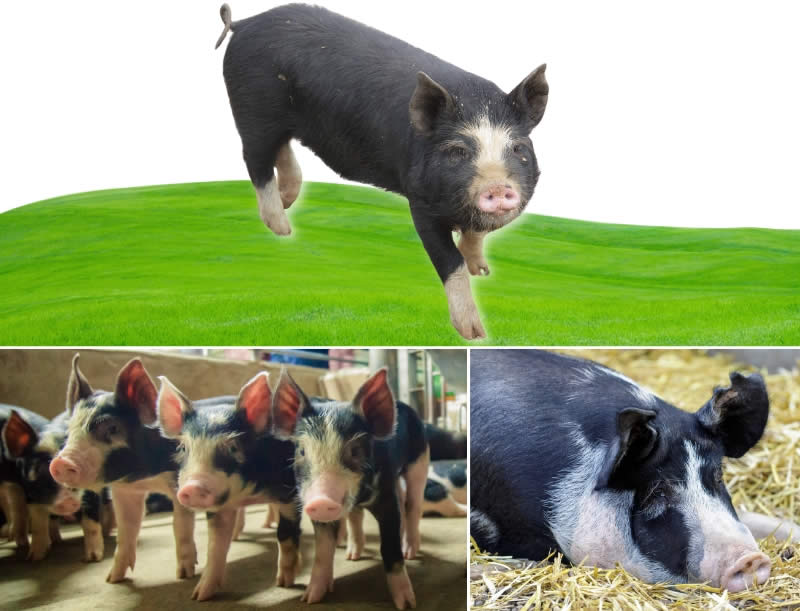
Origins
Berkshire pigs were created through a cross-breeding method in the late 18th century, where two different types of pigs were combined. The original Berkshire pig had a reddish or sandy brown color, and it was crossbred with small black pigs from Asia.
Traits
They are considered lard pigs due to their high concentration of fat. They are also part of the large breed of pigs because of their size.
Other Berkshire pig traits are:
- Large size
- High concentration of fat
- Rich, dark skin color
- Easy to raise
- Good carcass quality due to their robustness
- High fertility rate
- Longer lifespan than other breeds
- 8 to 10 Berkshire piglets per litter twice per year
Known for:
Berkshire pigs are primarily used and bred for their high-quality meat.
Their meat has a rich, dark color and is renowned for its excellent marbling, tenderness, and rich flavor. In the culinary world, Berkshire meat is considered an extraordinary culinary delight.
Regarding their characteristics, Berkshire pigs are an easy breed to raise. They have great carcass quality due to their robustness, good temperament, and fast growth rate, and are relatively adaptable to different environments.
Also, Berkshire gilts and sows can have litters of about 8 to 10 piglets on average and can even give birth to two litters of piglets each year, making them a great choice for breeders.
Good for:
Overall, the Berkshire pig can be a viable option for those seeking a breed that offers high-quality meat and ease of management.
2. Duroc
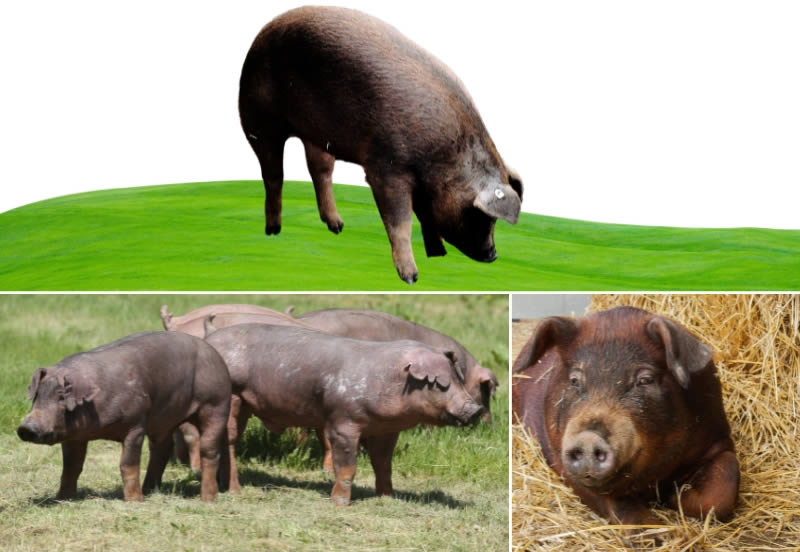
Origins
The Duroc pig is a domestic pig and one of the oldest pig breeds. This type of pig appeared from cross-breeding between red pigs from New York called Red Durocs or Jersey Reds and other mix-breed commercial hogs.
Traits
Red Durocs or Jersey Reds have passed on some traits that are highly valued by any farmer. Overall, the result of this crossbreeding was a success.
Among the defining traits of this pig are:
- Deep red skin color
- Fast growth ability
- Ability to convert feed into muscle mass, even with minimal amounts
- Robust muscular body and great carcass
- Calm personality
- Large litter sizes
- Longevity of sows
- 10 to 15 Duroc piglets twice a year
Known for:
From the first breeding, this was recognized as one of the best meat pigs for small farms. All these positive traits still make Duroc pigs very appealing, so much so that farmers continue to crossbreed them to improve different types of pigs.
The main reason for raising Duroc pigs? Apart from their almost perfect traits, Durocs are raised for their meat quality. Their meat is known for its reddish color, excellent marbling, juiciness, and flavor.
The best part is that, like Berkshire pigs, Durocs have darker skin, making it easy for farmers to raise them outdoors because they do not suffer from skin burns.
3. Hampshire
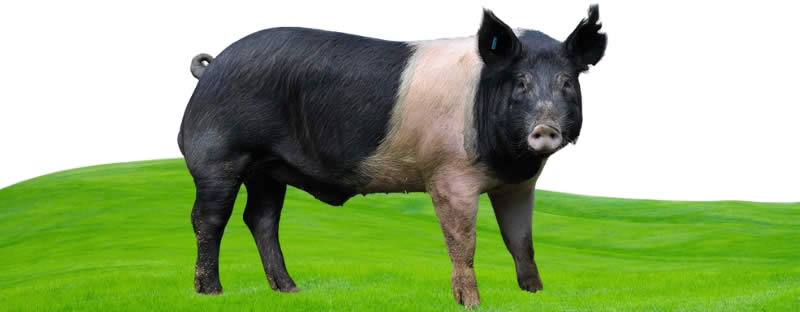
Origins
The Hampshire pig is the oldest breed of hog in America, with origins in England, specifically Northern England and Scotland. Although it originated in England, the Hampshire breed was developed in America by cross-breeding English breeds with American hogs.
Traits
Despite its English roots, the Hampshire pig boasts several distinct traits:
- Fast growth rate even faster than the Yorkshire pig
- Medium-to-large muscular body
- Excellent carcass quality
- Extra longevity in sows
- Good temperament and easy handling
- Prolific breeding
- Good mothering skills
- Long lifespan of up to 12 years
- Large litters of up to 12 piglets.
Known for:
Hampshire pigs are generally raised and preferred for their excellent meat.
But why is it excellent?
They have one of the leanest meats of all without any excess fat. Their back meat is the most popular and desired, especially among chefs for making delicacies. Additionally, their large size provides an abundant amount of meat. Apart from all that, Hampshire meat is also used in bacon and ham production.
Good for:
These pigs can be successfully raised by homesteads, small farms, and commercial pig-farming businesses.
4. Chester White
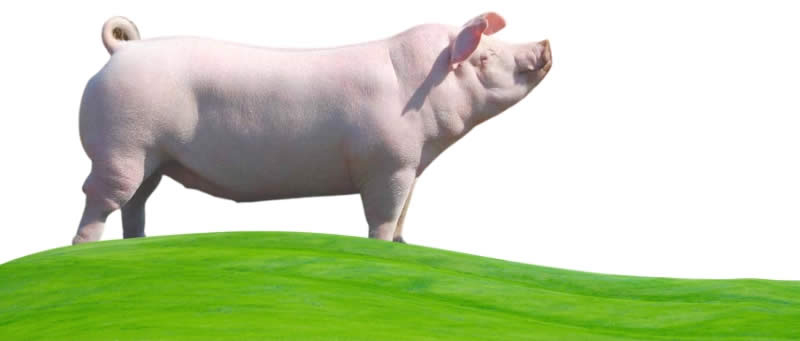
Origins
Originating in Pennsylvania, Chester White pigs are domesticated pigs that were developed through crossbreeding of large local white pigs and white boars imported from England.
Traits
These pigs typically have medium to large size and solid white skin. They are usually bred for their high-quality meat, but their traits also make them good for breeding selection, including:
- Durability as they are the most durable pigs among the white breeds
- Docile and friendly temperament
- Superior meat with high-fat content
- Soundness
- Great mothering ability
- Acceptable lifespan of 6-8 years
- High fertility
Known for:
Although Chester White pigs are relatively slow-growing compared to more popular breeds like Duroc and Yorkshire, they have a good feed-to-meat conversion rate, requiring less feed to produce more meat.
As mentioned, Chester Whites are primarily bred for meat production, with their meat having a high-fat content and distinctive flavor, making it ideal for bacon.
Good for:
In summary, Chester White pigs are versatile and can be successfully raised in a range of farming systems and environments. They are a popular choice for both small and large-scale pig farmers.
5. Landrace

Origins
Another white domestic pig on the list is the Landrace pig. Landrace pigs were produced by crossing the native pig in Denmark with other large white pig breeds. Years later, this pig breed is still used for crossbreeding and improving the meat quality in other pig breeds.
Traits
They are highly versatile pigs that can be raised in various indoor and outdoor management systems.
Their traits include:
- Muscular body
- Great body length
- Long lifespan of 10 to 15 years
- Great mothering skills
- Producing large litters of 10 to 15 piglets
- Intelligence
- Calm temperament
Known for:
Are Landrace pigs good for meat? Yes, Landrace pigs are good for meat production as they are specifically raised for it. What makes them stand out from other types of pigs is their well-fleshed carcass, which is usually used in fresh pork, ham, and bacon production.
Their meat has a well-marbled appearance due to the intramuscular fat and has perfect tenderness, juiciness, and flavor.
Good for:
Are they great to be raised? Landrace pigs are a popular choice for commercial pig farming due to their easy and quick adaptation and good feed-to-meat conversion rate.
6. Poland China

Origins
Warren County, Ohio is the birthplace of the Poland China pig, which was created by crossbreeding small Chinese pigs with various European pig breeds including the Berkshire.
This pig breed is one of the oldest, largest, and heaviest pig breeds. With its long history and large size, this type of pig is an excellent choice for farmers looking to raise pigs.
Traits
The Poland China pig has the following traits:
- Large and robust body and carcass
- Ability to produce large litters of up to 17 piglets
- Calm temperament
- Long lifespan.
Known for:
Raised primarily for meat production, the Poland China pig is actually a lard pig that produces a great quantity of lean meat as well.
This omnivorous pig enjoys eating both plants and animals and has an excellent feed-to-meat ratio, easily converting feed into quality meat.
For farmers, this means lower expenses on feed and more meat. However, because these pigs grow to a considerable size, farmers who opt for this breed need to ensure they have ample space to raise them.
Good for:
The meat of the Poland China pig is highly prized in commercial pork production in the United States, and it is actually the top-ranked breed for this purpose.
Common products made from this pig breed include ham, sausages, bacon, and pork chops.
7. Yorkshire
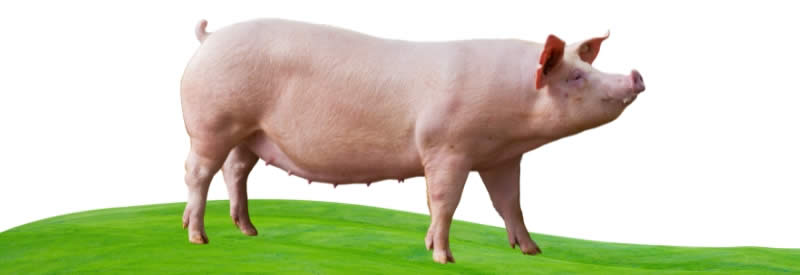
Origins
Originating in England in the 18th century, the Yorkshire pig was developed by crossing large indigenous white pigs of Northern England with smaller white Chinese pigs.
The Yorkshire pig is a medium-sized breed with a robust and sturdy body and excellent length.
Traits
Among its main traits are:
- Ability to produce large litters of up to 12 Yorkshire piglets
- Exceptional mothering skills
- Lifespan of up to 10 years
- Impressive meat quality
Known for:
Despite its amazing traits, the Yorkshire pig is known for having a slow growth rate.
While the Yorkshire pig may not be the fastest-growing breed, it remains one of the most popular breeds of commercial pork production in the United States.
Their meat is highly valued, particularly for bacon products.
Good for:
Another important thing about these medium-sized types of pigs is that they are very active. They love to run and explore, making them better suited for farms with ample space.
Without enough space to expend their energy, they may become difficult to handle. But when given enough room to move around, Yorkshire pigs are generally docile and easy to manage.
8. Large Black
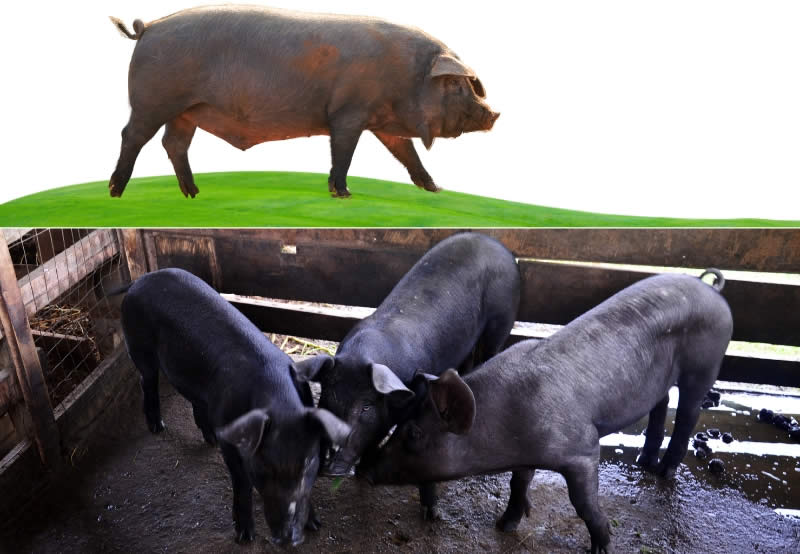
Origins
For small-scale or sustainable farming operations, a good pig breed is the Large Black pig. As the name suggests, this pig is large and black and appeared through breeding black pig breeds from Devon and Cornwall with other pig breeds from Essex, Suffolk, and Kent.
Traits
The traits of the Large Black pig include:
- Large body size
- Strong maternal instincts
- Long period of fertility
- Large litter size of 8-10 piglets
- Extremely docile and calm temperament
- Lifespan of up to 10 years
Known for:
Large Black pigs are raised mainly for their meat, which is lean, tender, and without an excess of fat.
Their meat was popular in meat production, especially for bacon, and is now often used in restaurants for special gourmet dishes due to its superior flavor and texture.
Good for:
This pig breed does well in all climatic conditions and is friendly and social, doing well in groups of animals.
The perfect environment for these pigs is outdoors, and they do not do well in intensive pig farming systems.
9. Large white

Origins
The Large White pig is one of the most popular breeds for intensive pig farming worldwide. They are derived from the Yorkshire pig breed, but their exact origins are difficult to trace.
Traits
The key characteristics of this pig include:
- Long and large body size
- Fast growth rate
- Exceptional mothering skills and high milk production
- Large litter sizes
- Gentle and friendly temperament
- High adaptability
Due to their hardiness and adaptability, the Large White pig is commonly used in modern breeding programs. It has been a favorite breed for decades.
Known for:
Like many other pig breeds, Large White pigs are mainly raised for their meat. Despite their large size and fast growth rate, these pigs do not store a lot of fat. The bacon industry is the primary consumer of lean meat, which has the perfect percentage of fat.
Good for:
Can Large White pigs be raised by small farmers too? Yes, definitely. Large White pigs can thrive outdoors in open spaces or confinement. Their ability to adapt quickly to confinement makes them a preferred breed in commercial hog farming operations.
10. Gloucestershire Old Spots
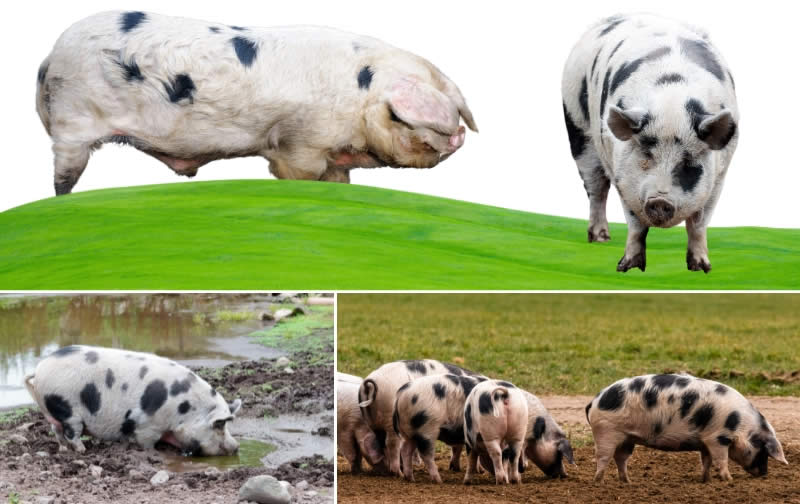
Origins
The Gloucestershire Old Spot (GOS) is one of the oldest pedigree spotted pigs in the world. These pigs have a similar appearance to Dalmatians, with white coats and black spots. Gloucestershire Old Spot pig must have at least one black spot in order to be registered as a GOS.
This breed was developed in the Vale of Berkeley in Gloucestershire, England, but the exact breeds involved in the pairing are not fully known. Some believe that the GOS is a cross between the original Gloucestershire pig (a large off-white pig with floppy ears and wattles) and the unimproved Berkshire (a sandy-colored pig with prick ears and black spots). However, both breeds are now extinct, so it is impossible to know for certain.
Good for:
Despite their unknown origins, GOS pigs are great foragers and can easily integrate into a small farm. They are self-sufficient and are a perfect pig breed for farmers looking to raise pasture pigs.
Traits
GOS pigs are docile, intelligent, and prolific, with sows able to have an average of 10 piglets per litter, with some having up to 12. Additionally, sows possess great maternal skills and high milk production.
Known for:
As for their meat, GOS pigs have a very dark color, excellent marbling, and a succulent texture. GOS pigs can vary in weight and fat percentage. Those who prefer fattier meat can allow these pigs to gain more weight, while others may choose to keep them at an average weight.
Unfortunately, the GOS pig is classified as a critically endangered breed by The Livestock Conservancy due to its low numbers. There are fewer than 200 annual registrations in the United States and an estimated global population of fewer than 2000.
11. Mangalica(Mangalitsa)
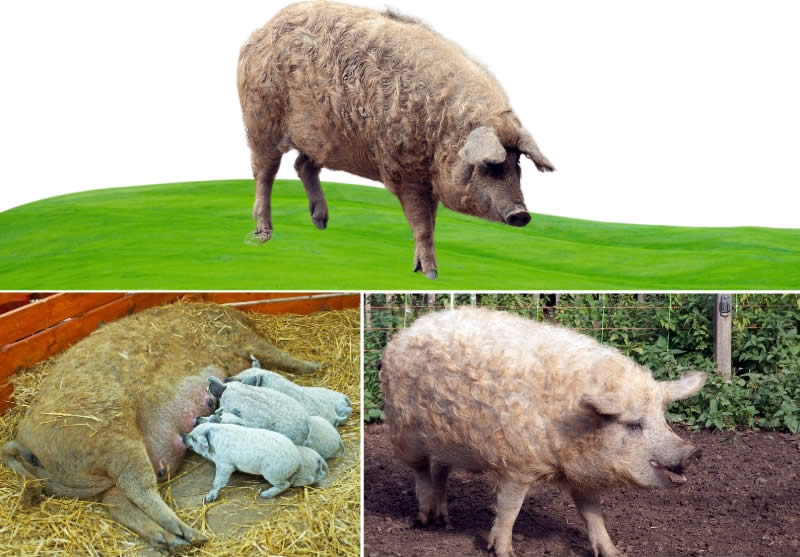
Origins
While there are many distinct breeds of pigs, the Mangalica pig is truly exceptional and stands out from the rest due to its distinctive woolly coat and unparalleled meat quality.
This domestic pig was created by crossbreeding different breeds from Romanian Salonta, Hungarian Bakony, European wild boar, and Serbian Šumadija. The Mangalitsa pig is different due to its unique blonde woolly coat, and it’s the only remaining breed of pig that has its skin covered with wool.
Traits
Despite the thick wool, they can thrive in various climates, from cold temperatures to warm environments like Florida or California.
Mangalica pigs love to spend time outdoors and are low-maintenance as they are natural foragers. They enjoy foraging in forests, pastures, and meadows. Their temperament is calm and easy-going, and they socialize well, making them ideal for group raising.
Known for:
The meat of Mangalica pigs is highly appreciated by chefs due to its diet of forage, wheat, and barley, which leads to high marbling, creamy white fat, and high levels of omega-3 fatty acids and natural antioxidants.
The carcass has 65-70% fat and 30-35% lean meat.
The lard from Mangalica pigs is different from other pig lard as it is lighter and melts at a lower temperature.
Good for:
These pigs require so little care that they are good for small farms and homesteaders who want to raise pigs and enjoy excellent meat.
12. Idaho pasture
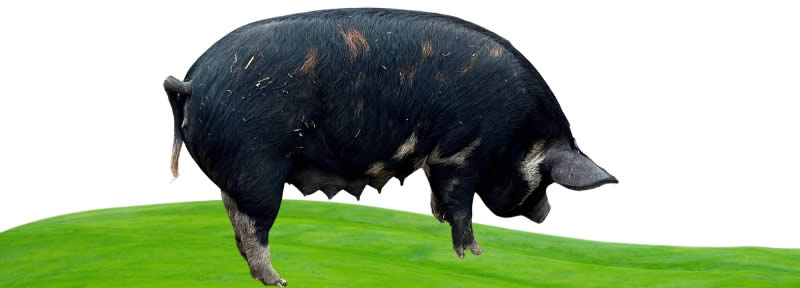
Origins
Idaho Pasture Pigs are a relatively new breed in the world of pig breeding, having been developed in the US in 2006. To create the breed, breeders crossed three pig breeds: Duroc, Old Berkshire, and Kunekune pigs.
Traits
The resulting pigs are medium-sized, with boars weighing around 600-700 lbs and sows weighing around 400-500 lbs. Despite being smaller than traditional pig breeds, Idaho Pasture Pigs have robust bodies with long backs and well-developed shoulders.
Other traits inherited from the three breeds include:
- Gentle and docile temperament
- High fertility with the ability to produce large litters of up to 10 piglets
- Strong mothering skills.
One unique trait of Idaho Pasture Pigs is that they graze grass instead of rooting like other pigs. While Idaho Pasture Pigs graze on grass, they require supplemental feed to meet their dietary needs. Despite their grazing behavior, they are not exclusively grass-fed and require additional feed.
Known for:
Like other pigs, Idaho Pasture Pigs are raised for their meat, which is a delicacy due to their grass-fed diet. The meat is higher in omega-3 fatty acids and more marbled than other types of meats.
Good for:
Thanks to their small size, grazing behavior, and docile temperament, Idaho Pasture Pigs are suitable for both small farmers and larger commercial operations.
13. American Guinea Hog
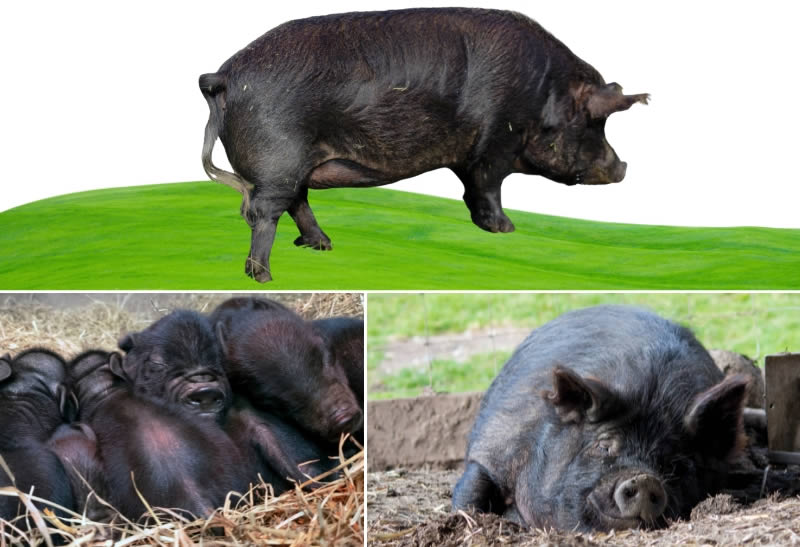
Origins
The American Guinea Hog is a small breed of domestic pig that has been around for centuries. The exact breeding that led to the creation of this breed is unknown, but some suspect that possible ancestors include a red Guinea pig that disappeared in the 19th century.
Traits
Some key traits of the American Guinea Hog include:
- Small size
- Adaptable nature
- Docile temperament and easy to handle
- Good foragers
- Long lifespan of 10 to 15 years
Known for:
The American Guinea Hog’s small size and friendly behavior make them not only great for meat production but also as pets.
They are known for being great with children and can make for caring and entertaining companions in the yard.
Good for:
This breed is a sustainable option for homesteaders and small-scale farmers due to its low-maintenance needs and low impact on the environment.
Their meat is highly valued for its dark and flavorful taste, often compared to wild boar meat. However, while American Guinea Hogs may be great foragers, they do tend to gain weight quickly.
Breeders and farmers need to monitor their diet and limit their grain intake to ensure they stay at a healthy weight.
14. Piétrain
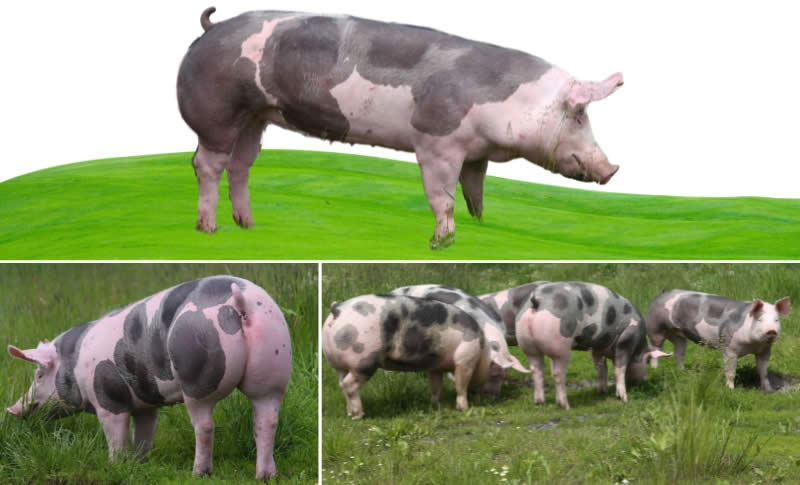
Origins
Piétrain pigs are named after the village where they originate from.
While their exact origins are unknown, it is believed that locals selectively bred them to create a highly muscular pig breed.
This is thought to be due to a genetic mutation, known as the halothane gene for Porcine Stress Syndrome, which causes hypertrophy. This gene makes them extra muscular.
Traits
Despite their bulkiness, Piétrain pigs are classified as a medium-sized pig breed and have a white-greyish piebald coat with some dark spots.
The sows of this breed are prolific, but they are known to lack mothering skills and milk production.
Known for:
Due to their hypertrophic nature, Piétrain pigs have a high percentage of lean meat, making them a popular choice for fresh meat production. In Europe, they are heavily produced in countries such as Germany and Spain.
However, some breeders prefer not to breed them with other pure Piétrain pigs due to their halothane gene. In countries like England, breeders choose to mix Piétrain pigs with other pig breeds and only maintain a small number of purebred Piétrain pigs.
15. Red Wattle

The Red Wattle Pig is one of the breeds listed as threatened by the American Livestock Breeds Conservancy. However, the Red Wattle Hog Association actively encourages farmers to help this breed grow and expand.
This breed is considered heritage, meaning that it has been preserved by farmers and breeders who value its unique characteristics.
Traits
Red Wattle pigs have robust, massive bodies and a red coat, with fleshy, wattle-like protuberances on their necks.
While some history suggests that this pig is the result of crossbreeding two wattled red sows with a Duroc, its true origins are shrouded in mystery.
These pigs are known for their mild temperament, resistance to disease, and fast growth. They are excellent foragers and well-suited for those who want to obtain pastured meat.
Good for:
They also do well in confined spaces and are a great choice for small farmers, as they are not challenging to raise and can provide a significant amount of meat. An adult Red Wattle pig can weigh between 800 and 1200 lbs.
Known for:
The meat of the Red Wattle pig has a very dark red color that is sometimes mistaken for beef. It is marbled and has a delicious flavor.
16. Vietnamese Potbelly
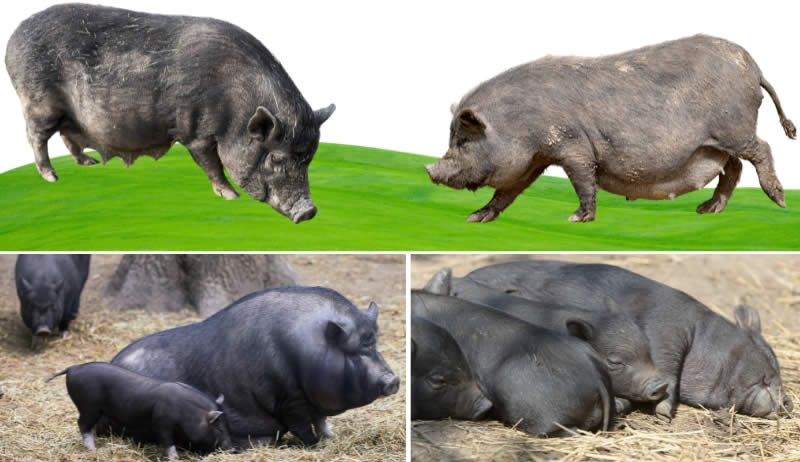
Origins
If you’re interested in small pigs, the Vietnamese Pot-bellied pig is a traditional breed of domestic pig originating from Vietnam. These pigs are relatively smaller than other types of pigs, and some even consider them to be miniature pigs or mini-pigs, making them popular as pets.
The exact origins of the Vietnamese Pot-bellied pig are not entirely clear, but it is believed that the breed appeared through the crossbreeding of various small pig breeds from Southeast Asia and China.
Traits
Regardless of how they were bred, these small pigs are known for their exceptional friendliness, calm temperament, and intelligence. They can even be taught tricks with a bit of patience, and they excel at socializing with other pigs or even other types of animals.
Good for:
Vietnamese Pot-bellied pigs are omnivorous foragers and love being outdoors. They are well-suited to muddy terrain or areas near water.
Known for:
Vietnamese Pot-bellied pigs are not typically raised for meat production. Most breeders prefer to keep them as pets due to their friendly nature. The good about these pigs is that they are resistant to diseases and parasites.
17. Mulefoot

Origins
The Mulefoot pigs are rare and unique and are considered a heritage breed by the Livestock Conservancy due to their historic significance and traits.
Although their origins are not exact, historical papers suggest that these types of pigs were first found in Indiana and some parts of Mexico.
Known for:
The breed was nearly extinct in the 20th century, but nowadays there are small groups of breeders that raise them for their meat. Most Mulefoot pig breeders can be found in the states of Missouri and Georgia.
Traits
Mulefoot pigs are small in size, with black color, and sometimes have white markings. They are named after their appearance, as they have a mule-like foot with a non-split hoof.
Good for:
They are gentle and calm and can thrive in various types of climates and environments. These pigs are natural foragers and appreciate their freedom and love terrain such as pastures and ranges.
The sows have good mothering skills, giving birth to an average of five piglets per litter. Still, the litter size of the Mulefoot breed is smaller when compared to other types of pigs.
18. Tamworth
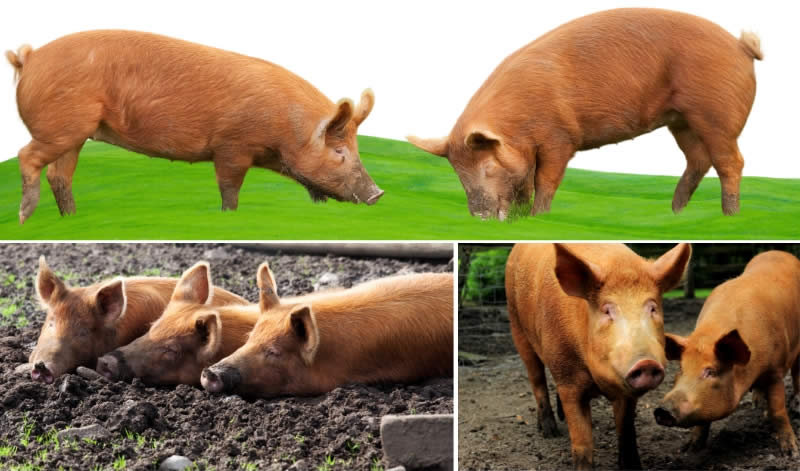
Origins
The Tamworth pig is a domestic breed of pig that originates in the United Kingdom and is among the rarest types of pigs in the world.
Traits
These pigs have a distinctive red color and are medium-sized with narrow snouts. Tamworth pigs are known for being extremely friendly, calm, and active, thriving in outdoor environments where they can forage all day long.
They excel at rooting and are a great choice for pasture management systems.
These brown pigs are a hardy breed, with natural resistance to diseases and parasites. However, they tend to have a slow growth rate and small litter sizes.
The Tamworth pig is one of the oldest pig breeds in the world, with origins dating back to the early 19th century. Despite their historical significance, Tamworth pigs are not as popular among breeders and farmers and are currently classified as a threatened breed.
Known for:
Although not a commonly raised breed, Tamworth pigs have great potential. Their meat is of high quality, with a unique flavor and tenderness, and the right amount of fat, making it perfect for bacon.
19. Hereford

The Hereford pig is a rare breed listed as a priority by the Livestock Conservancy, which aims to encourage breeders and farmers to help preserve this endangered breed.
Traits
These pigs boast an intense red color, a medium-sized body, and a friendly and docile temperament. They are highly adaptable to new environments and can be raised in both indoor and outdoor systems and various climatic conditions.
Known for:
Not only that, they are a hardy breed with a good growth rate and meat-to-fat ratio. Their meat is flavorful and tender, with the perfect amount of fat and lean cuts.
Good for:
Because of their easygoing nature, Hereford pigs are a great choice for small farmers or beginners interested in starting to raise pigs.
20. Kunekune

Origins
Kunekune pigs are a type of miniature pig that is perfect for small farms. They originate from New Zealand and can be considered a symbol of the area.
They are very friendly and easygoing, and according to some scientists, they have an amazing memory.
Known for:
Their cute appearance makes them popular as pets. Currently, Kunekune pigs are companion animals in countries such as Austria, Canada, Denmark, Germany, Portugal, Switzerland, and the United States.
The only place where they are not allowed is Australia due to biosecurity reasons.
Traits
These pigs come in different colors, including black, white, ginger, cream, gold, black and white, and even tricolored.
They can live for 8 to 16 years, give birth to 6 to 12 piglets per litter, and weigh up to 220 lbs.
6 things to consider when choosing a type of pig
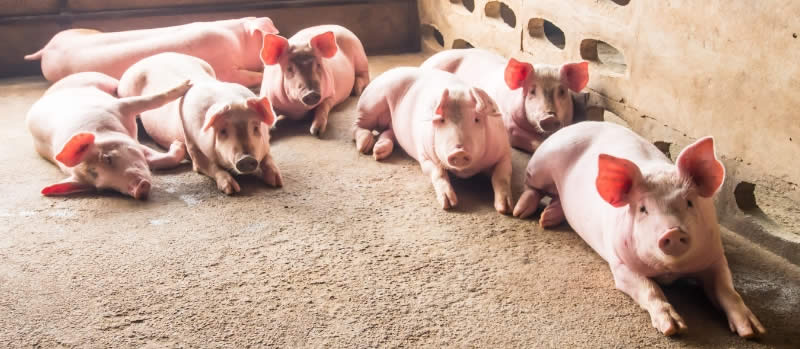
There is no right or wrong type of pig, only a type that is suitable for your needs and circumstances.
As I mentioned earlier, the first thing to consider when choosing a specific type is the purpose or goal you want to achieve.
However, there are other factors to consider as well. Here are some suggestions for what to consider when selecting a pig breed:
1. Climate
The pig you choose should be one that can thrive in the climate of your area. Some pigs are adapted to warmer weather, while others thrive in colder climates. Some pigs are highly adaptable and can handle various types of climatic conditions.
2. Space
Do you already have a prepared space for your pigs? If not, how much space do you have available? Some types of pigs are larger and require a larger amount of space. On the other hand, there are medium-sized pigs that love to be active and need more space to consume their energy. So, try to get an idea of how much space you are willing to allocate for raising pigs.
3. Feed
Some pigs are good foragers, while others are not. Some pigs need only a small amount of feed in addition to what they graze on, while others are more dependent on the feed you provide. You have to consider that some pig breeds have higher feed requirements than others, and these requirements should align with your budget as well.
4. Disease resistance
Do you want a pig that is more disease-resistant or does this aspect not concern you at all? Some pigs are not affected by common pig diseases or parasites, while others may require more antibiotics and veterinary visits.
5. Market demand
This factor applies only when considering starting a business as a pig farmer.
When you are raising pigs for personal consumption, you are not interested in the market demand for the type of pig you raise, but rather in the type of pig you prefer personally.
From a business perspective, you should research which type of pig has a higher demand on the market. Some pigs have higher demand but are cheaper, while others are less required on the market and the price for the meat is more expensive.
6. Temperament and behavior
These are crucial factors to consider when choosing a pig breed. While the majority of pigs are known for their calm and easy-to-handle nature, there are some breeds quite difficult to handle.
It is not possible to control pigs or change their behavior. Nowadays, there are plenty of management techniques and tools like, for example, an electric cattle prod that can be used to keep them in place.
From my personal experience, I had a few Duroc pigs that foraged extensively on my land. They gave me a hard time for a while. But, I learned my lesson.
So, always consider the temperament and behavior of the pig breed.
Pig breeding concept
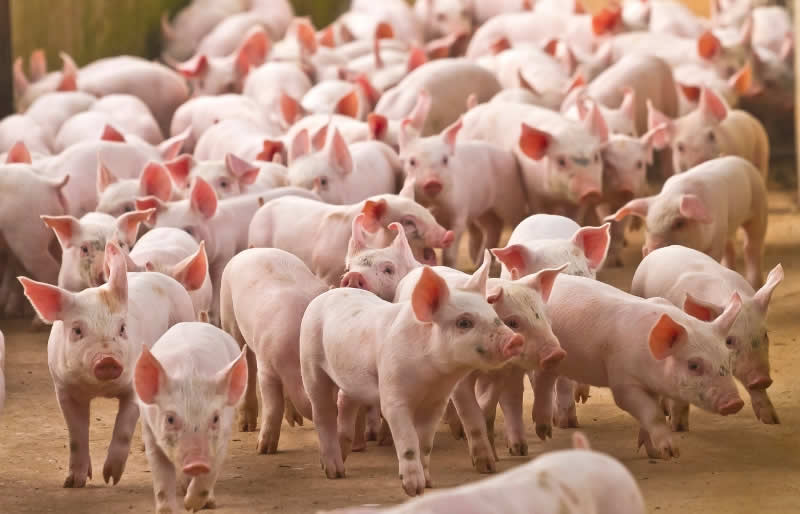
There are many different types of pigs in the world with each pig breed being developed over time by people for different purposes.
The process of creating new types of pigs is known as pig breeding. Pig breeding is very similar to any other animal breeding.
Pig breeding involves selecting and mating pigs with specific traits in order to produce new pig breeds with the same desirable traits. Through this process, new types of piglets are created that inherit the desired characteristics.
In general, the most common desirable traits that pig breeders look for in pigs are meat and carcass quality, disease resistance, fertility, temperament, feed efficiency, and size.
Aside from meat quality and production efficiency, contemporary pig breeding also emphasizes enhancing animal welfare and minimizing the environmental footprint of pig farming.
Now, you may be wondering about the specific characteristics of a good breeding pig and the selection process involved.
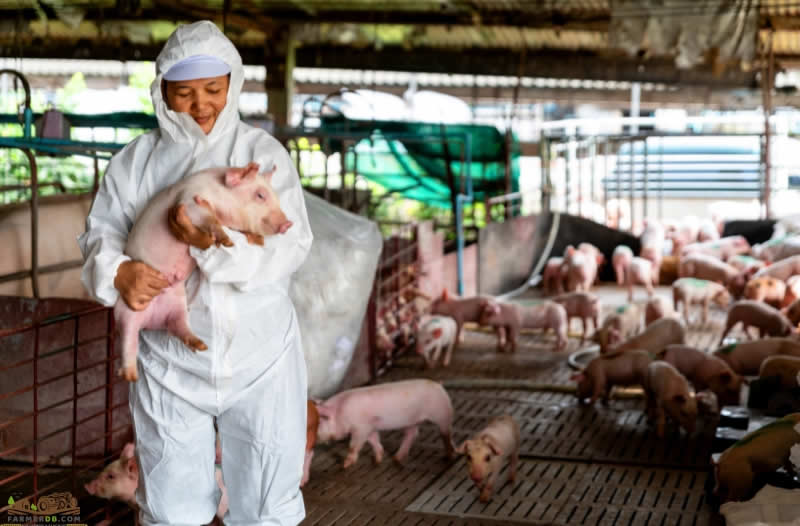
Animal breeders use a range of techniques, from simple observation to molecular markers and genetic analysis, to create the ideal combination of traits in their animals and ensure the best possible outcomes in their breeding programs.
Some breeders choose to use advanced tools like molecular markers, genomic selection, or genomic editing to identify pigs with the greatest genetic potential for specific traits based on their DNA. This method is more accurate and safer than the one that involves observation.
When breeding for meat quality, pigs should have traits such as a fast growth rate, high muscle content, and efficient feed conversion. For breeding healthier and disease-resistant pigs, selecting for resistance to common diseases like swine flu and foot-and-mouth disease is important.
Docile and calm pigs are often preferred in breeding programs because handling them requires less effort. When it comes to feeding efficiency, breeders prefer pigs that can convert feed into meat efficiently because this reduces the cost of production for the pig farm.
In the end, it all depends on the individual farmer and the specific needs and goals of their farm. Generally speaking, meat production and quality are the primary reasons for breeding pigs.
With so many different breeds of pigs, how can the quality of their meat vary so widely? Believe it or not, the quality of their meat can vary significantly.
Some pigs have rich, dark-colored meat that is very tender and flavorful, while others have reddish meat that is juicy. Some breeds have leaner meat with a slightly nutty flavor, while others have a mild flavor that is perfect for processed products such as sausages or hams.
There is much more to discuss about pig breeds and their traits, but it is best to take each breed individually and detail their specific characteristics and traits.
For in-depth information, do not hesitate to read the detailed articles on our website about each type and breed of pig. By reading these articles you will find vital information that will help you in the selection decision of the breed.



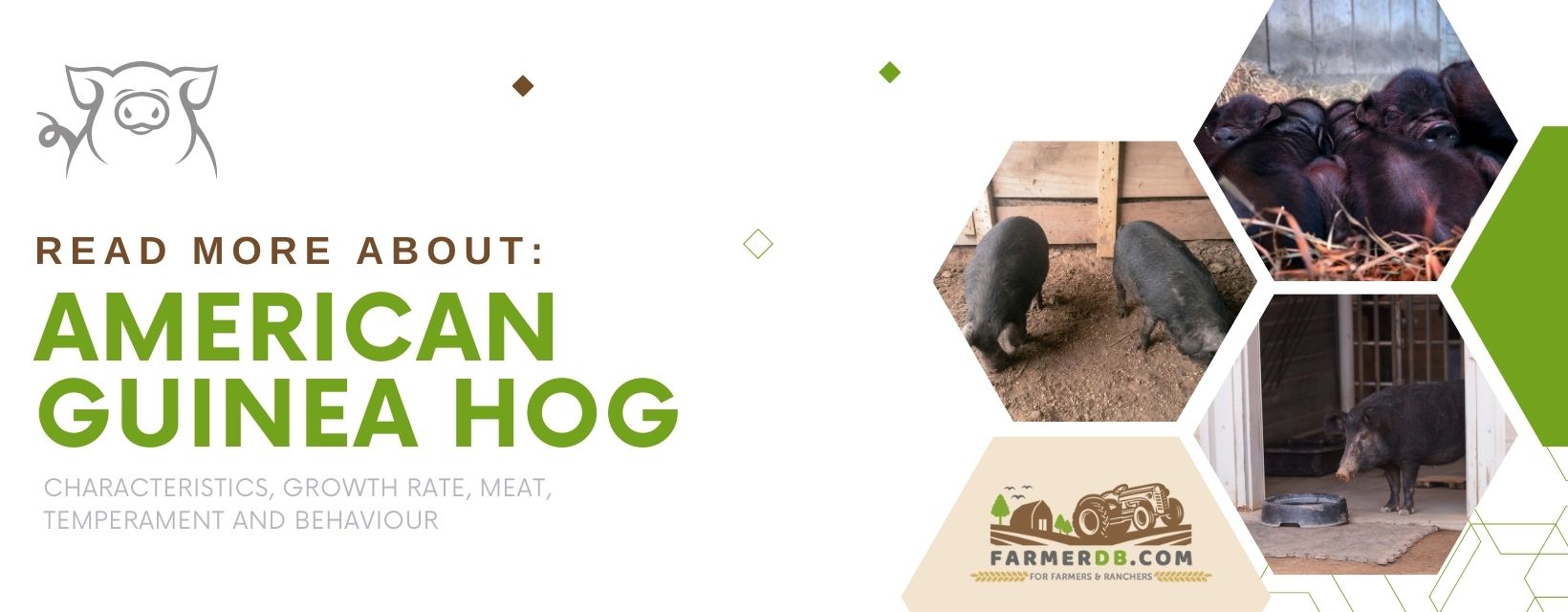
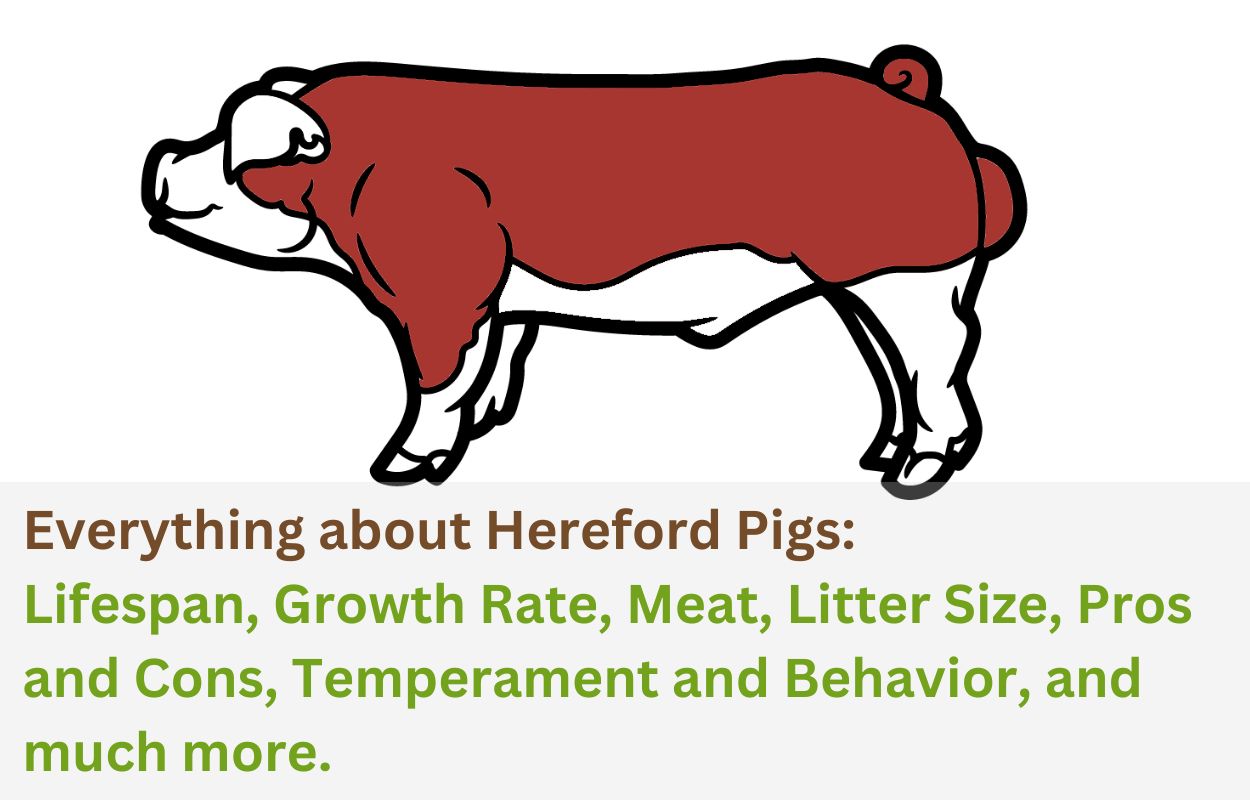
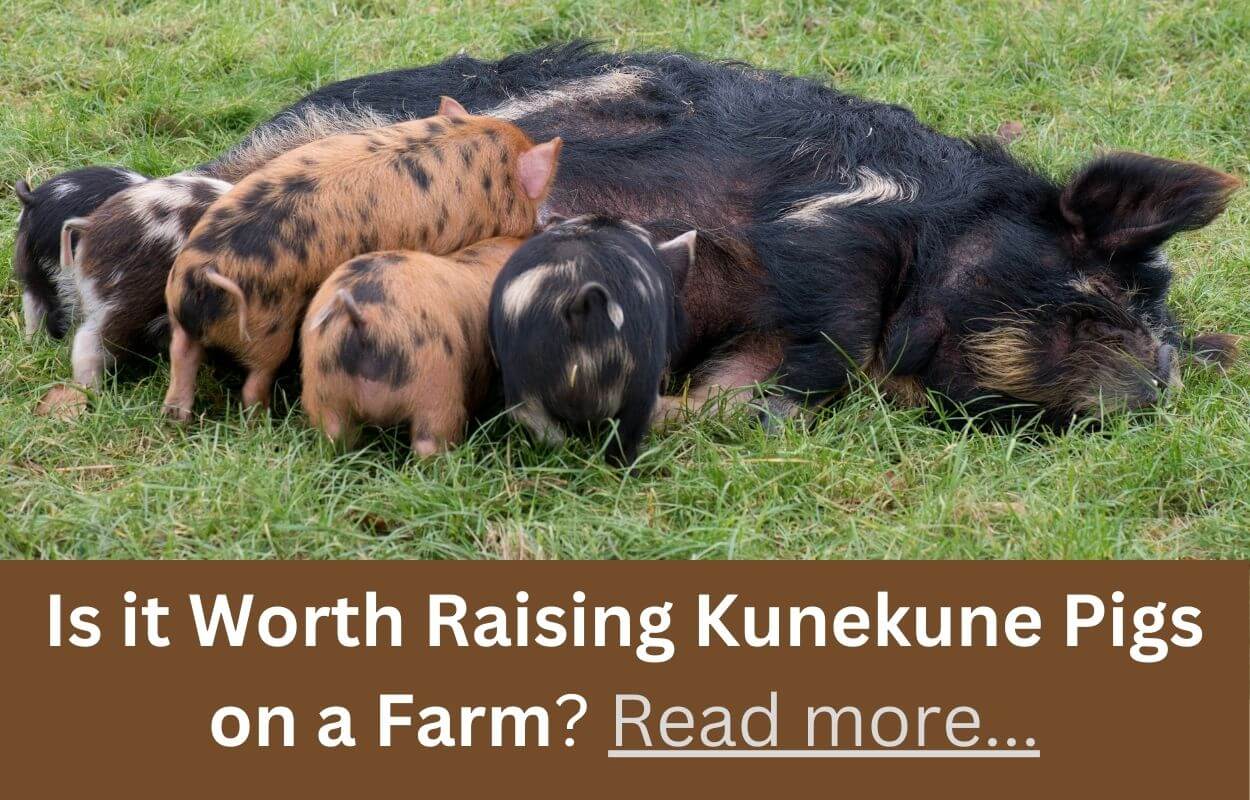


I am.interested to know more about pig spicoes
I am interested in starting a pig farm
Already I. Ve got more pigs at home. And I just want to know more about pigs
Hi Stanley,
What breed of pigs did you get? So I can give you more specific details and know exactly what you’re interested in.